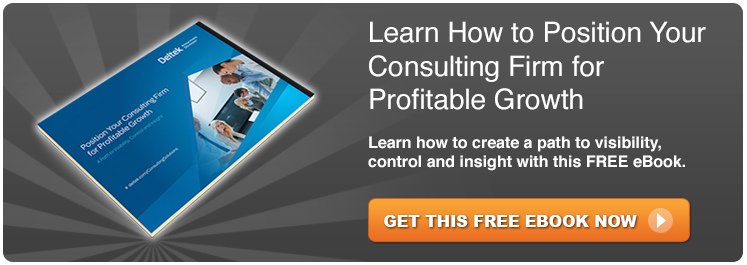This article was originally published in Consulting Magazine by Claus Thorsgaard
How agile is your firm? The ability to be agile can result in several key business benefits. It could mean being able to quickly respond to new opportunities, react to change, and adapt to challenges in ways that you never imagined. When agility is embraced in a firm, there are several outcomes: new business wins and efficient responses to change, thus maintaining profitability, happy clients and good positioning for growth.
1. Win New Business
In highly competitive markets like architecture, engineering and professional consulting, firms must respond quickly to win new business opportunities—or risk losing a chance at the sale. So how can agility help?
Propose quickly, yet accurately. Agile firms can quickly identify relevant historical client work to serve as insight for new proposals. Looking at similar past work helps determine what led to profitable results last time, which talent was involved, and whether the pricing was competitive, yet profitable. But you don’t have time for long, complicated data-mining; consultants and project managers need information on tasks, resources and availability, all in one place. Further, the information must be easily retrieved and sorted along any of the many variables you may be looking for (for example, by client, by vertical, or by service type). Fortunately, modern tools can help transform all of your firm’s past and current work into meaningful on-demand knowledge.
Similarly, an agile firm can easily determine if the right types of resources are available and not soft-booked for future work. Quick identification of current and future capacity helps the firm commit to the timeline and even assign specific, knowledgeable resources if requested by the client. This means having accurate information of current work, upcoming future work and resource availability—organized and noted by skill sets, talent and experience level. The information should be easily retrievable, not locked away in various information silos, and only available to the one team member with access.
Imagine the advantage for a consulting firm that quickly responds to a new business opportunity with an immediate proposal that commits to the resources and timeline, and shows examples of relevant past work. Putting yourself in your prospect’s shoes, which firm would you choose?
2. Grow Profitably
Even the best-planned projects or consulting engagements are still subject to change: resources can shift, scopes can change, and budgets can fluctuate. Though these changes typically have adverse effects on profit margins, agility helps firms to respond appropriately, thus maintaining, rather than jeopardizing, their expected margin on the work.
Picture an project or engagement that suddenly expands in scope to add an extra assignment. An agile firm quickly determines who has the appropriate skill and available capacity to take on the additional work—and can see how this additional work will impact current and future work. Doing this means having the right information together; not only so that information is easily accessible, but also so the project or engagement manager can see the firm-wide cause and effect of making the change.
Picture the alternative: Firms with disconnected information may respond quickly but perhaps incorrectly. Taking on the expanded scope may have negative consequences, which could leave your professional services firm unable to service other work in the pipeline or over-extend its resource capacity.
Over-extending staff can jeopardize employee morale and can lead to robbing other teams of individuals to complete the work, with detrimental effects that include understaffing other projects and delivering a lower quality of work.
3. Delight Clients
Agile firms are better positioned to satisfy clients, and manage their expectations. Flexible processes give firms the agility they need to respond to client demands. Consider a client who prefers an invoice that includes a complete breakdown of the work provided, as opposed to a top-line description.
Firms with rigid, inflexible systems may not be able to produce such an invoice, leading to an unsatisfied client. Or they’re left with highly manual processes, which are inefficient and lead to errors, and also affect client profitability. We all want to satisfy, and even delight our clients; wouldn’t you like client satisfaction to be profitable?
4. Capture Opportunities for Growth
Finally, agile firms are better poised to respond to growth opportunities. Responsive organizations can modify their processes and structure to react to new business opportunities, like new service offerings or expansion into new geographies.
Often, the key to such an agile response lies in systems that can quickly adapt to these opportunities, because minimal internal retooling or reorganization is needed, and also inexpensively, because such systems don’t need inefficient and cumbersome manual steps as a stop-gap while being retooled.
Getting Started
Don’t be overwhelmed. Just keep in mind that agility means accessible information and organization. It’s not about introducing hundreds of new procedures, check-in points or processes; it‘s about empowering staff at all levels with crucial data personalized to the needs of the client or project.
If “growth” and “profitability” are the first words that you want to come to mind as you describe your firm, then “agile” must come close behind. Only when your firm is truly agile can it consistently capture new business, respond quickly to change, and position your firm for continued growth.
Did you find this article interesting? You might also enjoy reading the 4 Ways to Consistently Maintain Profitable Projects.
Claus Thorsgaard is Deltek’s EVP and general manager, professional services. (Follow him on Twitter)


[/fusion_builder_column][/fusion_builder_row][/fusion_builder_container]







